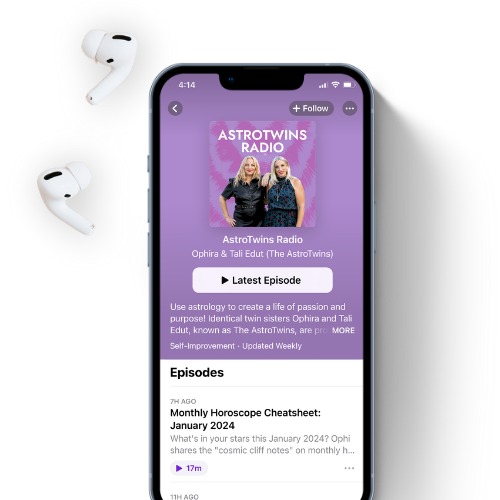A Synastry relationship chart combines is a side-by-side comparison of your chart and someone else’s chart. Astrologers read seven major angles between the signs to determine compatibility.
The synastry relationship chart is a method of reading a side-by-side comparison of two birth charts. The distance between your planets and another person’s can tell you so much about how you’ll relate. Will you get along smoothly or need to compromise? Will your interpersonal dynamics be so easy it’s actually a little boring—or constantly charged with tension?
For example, if you have Venus in Aries and your partner has Venus in Gemini, your Venus signs form a “sextile” angle. Sounds pretty juicy already, doesn’t it? But this is actually more of a BFF-with-benefits vibe.
There are seven major angles between signs, which create the dynamic distance of compatibility.
These angles are so important that they even have names. The seven major angles (also called aspects) are what astrologers look at when comparing two charts for a Synastry relationship chart.
Our new podcast is here!
AstroTwins Radio
Subscribe and join us every week wherever you get your podcasts!
Listen here
The seven major angles (or aspects)
The distance between planets in your charts is described as follows (and explained in more detail in below):
Same Sign: Conjunct
1 Sign apart: Semisextile
2 Signs apart: Sextile
3 Signs apart: Square
4 Signs apart: Trine
5 Signs apart: Quincunx
6 Signs apart: Opposite
The “secret of distance” in reading the angles in a synastry chart
Aspects represent different energies, some easy and others challenging. Often, there’s a mix of both in compared/synastry relationship charts. Discovering where things are easy can help you play to those strengths. And finding the rough spots shows you where you can improve.
When starting out with synastry readings, it can be helpful to compare the same planets. In other words, what’s the distance between your Sun sign and your partner’s Sun sign; your moon sign and their moon sign?
As you get more experienced with this, you can compare any two planets in the chart. So yes, this can lead to hours of fascinating discovery and obsession.
And the pitfall of reading the angles in a synastry chart
Don’t forget to actually have the relationship. A red flag of reading relationship charts is when you use the planets as a “reason” to cite incompatibility.
In our experience, we’ve seen people with challenging aspects between planets have dynamic and enriching relationships. What would be considered a “bad match” by simplistic thinking was actually what created the chemistry and spark!
So don’t get thrown off if you have a bunch of quincunxes and squares. Maybe you’ve met a lifelong teacher. The only way to know? Be present and experience each other off the charts.
Guide to the 7 angles (aspects) of Synastry relationship charts
When two planets are in the same sign, they double their impact. Wonder-twin powers, or too much of a good thing? Read more about this match
Two planets that are one sign apart have nothing in common. However, like next-door neighbors with totally different styles of decorating, they can learn from each other—as long as they don’t invade each other’s turf. Inconjunct planets won’t coexist easily, but they can act as ambassadors and teachers for each other. Read more about this match
This friendly, easygoing aspect doesn’t move mountains, but it adds a nice touch. Two planets that are sextile are like best friends who let each other shine, and work together easily. Read more about this match
In this aspect, two planets form a harsh 90-degree angle. The energy is like a tug o’ war, filled with dynamic tension, competition and the ultimate need for compromise. Square planets are like “frenemies,” on-and-off friends who can also be exciting rivals—and dueling divas! Read more about this match
Lucky triangle! The flowy trine angle brings effortless ease between two planets. A trine generally occurs between two planets of the same element (fire, earth, air or water). Trines show harmony, but also where we can get a little lazy when things come too easily to use. Read more about this match
Just like the semisextile (one sign apart), two quincunx planets have nothing in common. There’s a need to bring together two vastly different energies that can have little in common. Each will need to adjust or adapt to the other’s unfamiliar, even alien, style of doing things. Read more about this match
Opposites attract—and repel! Two planets in opposite signs can make a great team. However, they will need to balance their strengths to avoid polarizing each other. Read more about this match
Another method for reading Synastry charts
Wheel to wheel comparison
There’s another method for synastry readings, which involves comparing two wheel-shaped charts. The benefit of this view is it allows you to look at the houses for yet another layer of fascinating, cosmic data. In order to accurately read the houses, however, you must have the birth time for both individuals. The accuracy of the houses depends on this.
In this method you cast the charts of both individuals, then place one chart in the center wheel and the second chart in the outer wheel. And yes, you then flip it for a second reading.
This method allows you to see what houses your partner’s planets fall into in your chart. From there, you can further speculate on what areas of life you’re most likely to awaken, trigger and otherwise influence for one another.
You’ll need to use an app that allows you to do a two-wheel chart. Here we used Astro-Gold to do synastry for Meghan and Harry, the Duchess and Duke of Sussex.
View 1: Harry’s planets in Meghan’s houses
In the first chart, Meghan’s natal chart is placed in the inner wheel and Harry’s is in the outer wheel. We can see that Harry’s 22º Virgo Sun lands in Meghan’s third house of friendship, socializing and communication. The two were introduced by mutual friends and soon became inseparable, illustrating the kinship (and twinship) of the third house—which shares a lot of similar energy to Gemini, the zodiac’s third sign.
In the ultimate act of alliance—and defiance—Harry left palace life behind, changing his social standing in the UK to protect Meghan from the cruelty and racism of “the firm” and even members of his family.
Harry’s planets mainly occupy the lower half of Meghan’s chart, also known as the personal houses. He has been a source of emotional strength for her through the egregious and painful experiences she suffered in the early part of their marriage.
The two share a very close-knit relationship and have had to recreate their personal lives from the ground up as the result of their marriage. Relationships with both of their families have shifted but Harry has chosen to recreate a new life with Meghan that bears little resemblance to his royal upbringing.
View 2: Meghan’s planets in Harry’s houses
Meghan’s planets primarily sit at the top of Harry’s chart, influencing his relationships and public life. Her 11º Leo Sun (along with Mercury, Mars and her North Node) all land in his seventh house of committed relationships—a clear sign that being his wife was her destiny.
At the northern point of the chart, her Libra stellium (moon, Saturn, Jupiter, Pluto and the marriage asteroid Juno) straddle his ninth house of cross-cultural connections and global affairs, and his tenth house of public prestige. Her presence in his life definitely turned him into a new kind of global citizen!
And with these planets in couple-y Libra, it’s no surprise that their marriage pulled them both into the public eye and created a fan club for the royal couple outside of the UK.
We could keep on speculating for hours here. That’s the beauty and magic of reading astrology charts. This is more advanced astrology, but if your interest is piqued, practice makes perfect! Run synastry charts for people in your life and practice reading..
To learn all about the 12 signs and houses of the zodiac, read more in the Astrology section on Astrostyle!







